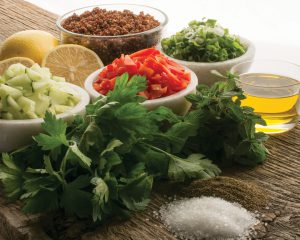Arab American Heritage Month is observed in April to recognize and celebrate the contributions of Arab Americans to the United States and to raise awareness about Arab American culture, history, and heritage.
The heritage month’s origins can be traced back to 2017 with an initiative by the nonprofit organization Arab American Foundation and its sister organization Arab America. According to the 2020 U.S. census, there are about 3.5 million people in the country who reported Middle Eastern and North African descent. The month was officially recognized in April 2021 by President Joe Biden and the U.S. Department of State, honoring the diverse populations of 22 countries in the Middle East and North Africa, including Algeria, Egypt, Iraq, Lebanon, Morocco, Palestine, Saudi Arabia, Sudan, Syria, the United Arab Emirates, Yemen, and others.
Arab American cuisine is known for its use of fresh, wholesome ingredients and a mastery of spices and herbs that add depth and complexity to dishes. Featuring aromatic spices like cumin, turmeric, and sumac, as well as fragrant herbs like mint and parsley, Arab cuisine has had a big impact on U.S. food culture, with many foods making their way into Americans’ daily lives. One of the iconic dishes of Arab American cuisine is hummus, a creamy blend of chickpeas, tahini, lemon juice, and garlic, drizzled with olive oil and sprinkled with paprika or sumac. Hummus isn’t just a dip; it’s also a symbol of hospitality, often shared with friends and family over pita bread.
 Another favorite food is falafel, which are fried balls made from ground chickpeas or fava beans and seasoned with herbs and spices. These are often served in pita bread with tahini sauce, fresh vegetables, and pickles, but you can also get creative and make falafel burgers, tacos, or waffles. Other popular dishes include mansaf (lamb simmered in a rich yogurt sauce and served with rice); shawarma (slow-roasted meat cooked on a vertical rotisserie); baba ghanoush (an eggplant dip similar to hummus); fattoush (a vegetable and pita salad); tabbouleh (a bulgur wheat and herb salad); mahshee (stuffed zucchini or eggplant); kibbeh (fried stuffed bulgur and meat balls); and koshari (a lentil, rice, and pasta dish with a vinegar tomato sauce and fried onions).
Another favorite food is falafel, which are fried balls made from ground chickpeas or fava beans and seasoned with herbs and spices. These are often served in pita bread with tahini sauce, fresh vegetables, and pickles, but you can also get creative and make falafel burgers, tacos, or waffles. Other popular dishes include mansaf (lamb simmered in a rich yogurt sauce and served with rice); shawarma (slow-roasted meat cooked on a vertical rotisserie); baba ghanoush (an eggplant dip similar to hummus); fattoush (a vegetable and pita salad); tabbouleh (a bulgur wheat and herb salad); mahshee (stuffed zucchini or eggplant); kibbeh (fried stuffed bulgur and meat balls); and koshari (a lentil, rice, and pasta dish with a vinegar tomato sauce and fried onions).
Knafeh, a traditional Arab dessert, is a decadent treat made from shredded phyllo dough layered with warm cheese, soaked in syrup, and topped with crushed nuts. Others include awwameh (a Middle Eastern twist on the doughnut that’s sweetened with rosewater syrup); baklava (layers of phyllo dough with nuts and drizzled with a sugary syrup); and maamoul (Lebanese shortbread stuffed with dates or nuts).
There are also several notable Arab American chefs who have made significant contributions to the food scene in the U.S.:
● Einat Admony is an Israeli American chef who has opened 13 restaurants throughout her career and owns the acclaimed fine dining restaurant Balaboosta in New York City, where she showcases her unique blend of Israeli, Yemenite, and Persian flavors.
● Palestinian American chef Michael Rafidi is the chef and owner of Michelin-starred Albi in Washington, D.C., focusing on updating traditional Arabic cuisine with modern techniques while using mid-Atlantic ingredients.
● Known for her dedication to preserving and celebrating Arab culinary traditions, Reem Assil is a Palestinian-Syrian American chef who owns Reem’s California and is a two-time James Beard Award semifinalist for Best Chef: West.
Try your hands at these traditional Arab dishes at home:Syrian Falafel Servings: 8
1 ⅓ cups dry chickpeas ⅓ cup yellow onions, chopped ¾ tablespoon fresh peeled garlic cloves 3 tablespoons fresh parsley 2 tablespoons fresh cilantro 2 teaspoons kosher salt 2 ½ teaspoons ground cumin 2 teaspoons ground coriander seed ¼ cup cold water
1. To prepare ingredients: Cover the dry chickpeas with water 5 inches over the top of the beans. Let sit for 24 hours. 2. Preheat fryer to 370°F. 3. Drain the chickpeas and discard the water. 4. In a food processor, add the chickpeas and pulse with the onions, garlic, parsley, cilantro, salt, cumin, and coriander seed. 5. Process the chickpeas, adding a little cold water at a time to help turn the mixture, until they’re well ground but not smooth. They should still be a little course. 6. Place the chickpea mixture in the refrigerator for at least 1 hour. Note: The chickpeas can be prepared well in advance of frying. 7. Portion the mixture into 2-ounce balls (roughly the size of a golf ball) and flatten slightly. 8. Fry until golden brown. Drain onto paper towel-lined pans and serve hot.
Grilled Eggplant with Moroccan Spices Servings: 8
2 medium eggplants 1 ¼ teaspoons ground coriander seed 1 ¼ teaspoons ground cumin ½ teaspoon kosher salt ¼ teaspoon ground black pepper ¾ teaspoon ground cinnamon ¼ teaspoon ground cayenne pepper 1 cup plain low-fat yogurt 2 tablespoons fresh parsley, chopped 3 tablespoons fresh mint, chopped 3 ⅓ tablespoons extra virgin olive oil
1. Preheat grill to medium-high heat. 2. To prepare ingredients: Partially peel the eggplants lengthwise with a vegetable peeler, leaving long strips of peel on the eggplant. Cut the eggplants crosswise into ½-inch-thick slices. 3. Combine the coriander seed and cumin in a skillet over medium heat, and toast for about 1 ½ minutes. Pour into a bowl and combine with salt, black pepper, cinnamon, and cayenne pepper. 4. Combine the yogurt, parsley, mint, and half of the spice mixture in a bowl. Whisk in extra virgin olive oil. Refrigerate until ready for use. 5. Lightly coat the eggplant slices with pan spray. Sprinkle evenly with remaining spice mixture. 6. Grill each slice for about 3-4 minutes on each side or until tender. 7. Arrange grilled eggplant on platter. Drizzle with herb yogurt mixture and serve immediately.







